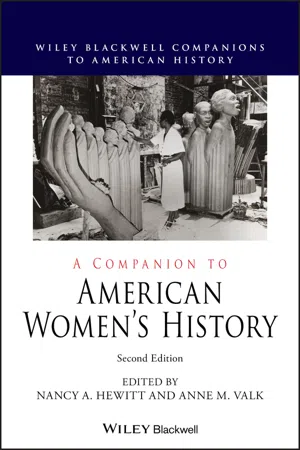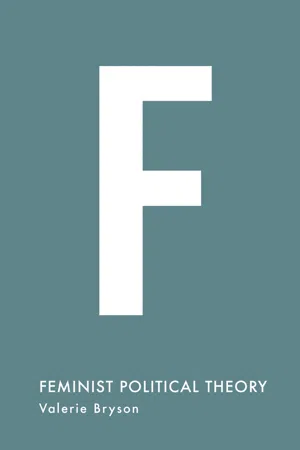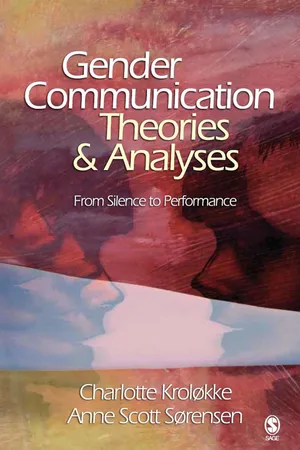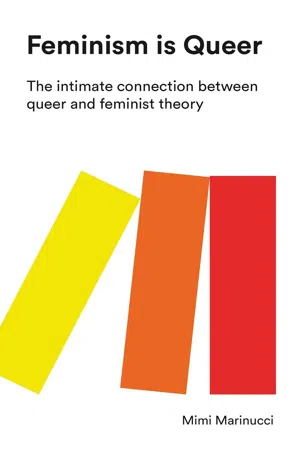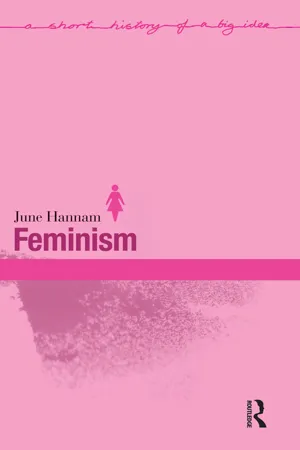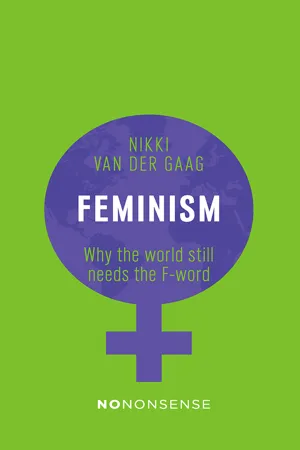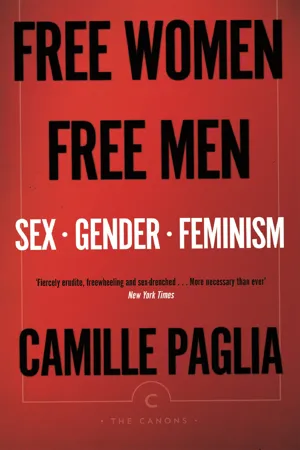History
US Feminism
US feminism refers to the ongoing social and political movement advocating for gender equality and women's rights in the United States. It has evolved over time, encompassing various waves such as first-wave feminism focused on suffrage, second-wave feminism addressing broader social and economic issues, and intersectional feminism, which emphasizes the interconnected nature of gender, race, and other forms of oppression.
Written by Perlego with AI-assistance
Related key terms
9 Key excerpts on "US Feminism"
- eBook - ePub
- Nancy A. Hewitt, Anne M. Valk(Authors)
- 2020(Publication Date)
- Wiley-Blackwell(Publisher)
Chapter Twenty‐One Rethinking Feminist Movements After World War IIAnne M. ValkFor more than a century, scholars and activists have imagined the history of feminism as a series of ocean waves that surge and recede over time. The 2002 edition of A Companion to American Women’s History accepted this conceptualization. Writing on “Second‐Wave Feminism,” Rosalyn Baxandall and Linda Gordon described the vibrancy and contradictions that made up the women’s movement after World War II. As the largest social movement in the history of the United States, they argued, modern feminism’s “impact has been felt in every home, school, and business, in every form of entertainment and sport, in all aspects of personal and public life.” The women’s movement “permanently altered the American landscape,” but Baxandall and Gordon warned that many victories were “vulnerable to attack and erosion” (2002: 414, 430).Historians’ understandings of feminism – its impact, legacy, agenda, ideas, and proponents – have become increasingly complex since Baxandall and Gordon surveyed the topic. Recent histories now question how the familiar narrative of separate waves reflects and perpetuates a vision of feminism that prioritizes the public agendas pursued by middle‐class white activists. Nancy Hewitt (2012 ), one of several scholars critiquing the wave framework, focused on the process by which historical narratives of feminism get reproduced in ways that stress homogeneity and unity and ignore diversity and conflict within each wave, while accentuating differences between waves. According to Hewitt, feminists in the 1960s believed their movement encompassed broader goals and participants than the suffrage‐focused first wave. Similarly, in the 1990s third‐wave activists considered their feminism more inclusive and more transformative than prior generations’. These characterizations helped generate collective identities and ideologies that catalyzed activism but also obscured continuities and common struggles and rendered invisible many people, organizations, and agendas crucial to the long women’s movement. Hewitt concluded that the wave metaphor “lends itself all too easily to Whiggish interpretations of ever‐more … sophisticated movements” through which activists distinguish themselves from prior generations by highlighting their own relative progressiveness (2012: 666). Similarly, Maylei Blackwell (2011 - eBook - ePub
Theories of International Relations
Contending Approaches to World Politics
- Stephanie Lawson(Author)
- 2015(Publication Date)
- Polity(Publisher)
and morality, as supported by the biblical account of the temptation of Eve in the Garden of Eden as well as the fact that she was created second to Adam (Hodgson-Wright, 2006, p. 5).The early feminist movement, now known as the ‘first wave’ of feminism, began in nineteenth-century Europe and North America and extended to settler colonies in Australia, New Zealand and South Africa. The campaign for suffrage saw voting rights for women introduced, with New Zealand leading the way at a national level in 1893. But the movement for equal rights was not confined to the West. In parts of the Middle East, India, China and Japan, movements emerged reflecting both the general principles of equality and the particular problems of women in those areas. In China, the issue of gender inequality achieved prominence in the mid-nineteenth century, when more general questions of reform and modernization came onto the social and political agenda. As in the West, the emphasis was on equal legal rights, as well as abolishing such practices as polygamy and foot-binding (see, generally, Yuan, 2005). At much the same time, the status of women in India began to be questioned in the context of widespread socio-religious reform. One commentator on this period notes the particularity of feminism in cultural terms but also remarks: ‘It seems to be a universal phenomenon that the definition and discourse on the “nature” of “woman” originated in commentaries on religious texts, which authorize patriarchal customs’ (Anagol, 2005, p. 20).It was not until the second half of the twentieth century that a ‘second wave’ of feminism prompted more significant social and political changes. This second wave was situated in a post-Second World War context of social and political change which saw liberation movements of various kinds emerge, including the decolonization movement. The most important feminist text in the immediate postwar period was produced in 1949 by Simone de Beauvoir, who looked in particular at the social construction of woman as ‘other’. Beginning with the observation that ‘One is not born, but rather becomes, woman’, she went on to suggest that ‘No biological, psychical or economic destiny defines the figure that the human female takes on in society; it is civilisation as a whole that elaborates this intermediary product between the male and the eunuch that is called feminine.’ In this process, the female is constituted ‘as an Other - eBook - ePub
- Valerie Bryson(Author)
- 2016(Publication Date)
- Bloomsbury Academic(Publisher)
5 LEFT-WING FEMINISM IN BRITAIN AND THE UNITED STATES FROM THE LATE NINETEENTH CENTURY TO THE SECOND WORLD WARAs we shall see in Chapter6 , by the late nineteenth century some European countries saw a sharp split between ‘mainstream feminists’ with their demands for equal political and legal rights, and Marxist socialists with their talk of class war and revolution. In both Britain and the United States, however, there was much more of a continuum, as the social concerns that had long characterised sections of the women’s movement merged with a more radical critique of existing society which led some to socialism as well as feminism. For most, this socialism was based on humanitarian ideals or a pragmatic response to poverty and the conditions of working-class life. Such socialism owed little to Marxist ideology, it favoured gradual and piecemeal reform rather than revolution, and it could seem readily compatible with a feminism based on ideas of social justice rather than on an analysis of patriarchy. In this context, socialism and feminism could be seen as complementary, promising equality and an end to exploitation for all. At the same time, other women activists developed their feminism in the context of anarchist or communist politics, insisting both that society must be radically transformed and that women must play a key role in this transformation, while some black women communists developed analyses of the intersections of race, class and gender that anticipate later thinking.BritainAlthough many male socialists supported feminist goals, in practice socialist organisations in both countries tended to combine formal commitment to a degree of sex equality with a marginalisation of ‘women’s issues’, discriminatory practice and a frequently unthinking sexism that permeated all levels of political and personal life. Thus Hannah Mitchell, a working-class socialist and suffrage campaigner from the north of England complained: - eBook - ePub
Gender Communication Theories and Analyses
From Silence to Performance
- Charlotte Kroløkke, Anne Scott Sorensen(Authors)
- 2005(Publication Date)
- SAGE Publications, Inc(Publisher)
1 Three Waves of Feminism From Suffragettes to GrrlsW e now ask our readers to join us in an exploration of the history of feminism or, rather, feminisms: How have they evolved in time and space? How have they framed feminist communication scholarship in terms of what we see as a significant interplay between theory and politics? And how have they raised questions of gender, power, and communication?We shall focus our journey on the modern feminist waves from the 19th to the 21st century and underscore continuities as well as disruptions. Our starting point is what most feminist scholars consider the “first wave.” First-wave feminism arose in the context of industrial society and liberal politics but is connected to both the liberal women’s rights movement and early socialist feminism in the late 19th and early 20th century in the United States and Europe. Concerned with access and equal opportunities for women, the first wave continued to influence feminism in both Western and Eastern societies throughout the 20th century. We then move on to the second wave of feminism, which emerged in the 1960s to 1970s in postwar Western welfare societies, when other “oppressed” groups such as Blacks and homosexuals were being defined and the New Left was on the rise. Second-wave feminism is closely linked to the radical voices of women’s empowerment and differential rights and, during the 1980s to 1990s, also to a crucial differentiation of second-wave feminism itself, initiated by women of color and third-world women. We end our discussion with the third feminist wave, from the mid-1990s onward, springing from the emergence of a new postcolonial and postsocialist world order, in the context of information society and neoliberal, global politics. Third-wave feminism manifests itself in “grrl” rhetoric, which seeks to overcome the theoretical question of equity or difference and the political question of evolution or revolution, while it challenges the notion of “universal womanhood” and embraces ambiguity, diversity, and multiplicity in transversal theory and politics. - eBook - ePub
Feminism is Queer
The Intimate Connection between Queer and Feminist Theory
- Mimi Marinucci(Author)
- 2016(Publication Date)
- Zed Books(Publisher)
CHAPTER 7 Feminism re-examined and reconsidered “Now you’ve got your diploma, Em,” said Uncle Henry, with a laugh, “and I’m glad of it. This is a queer country, and we may as well take people as we find them.” L. Frank Baum, The Emerald City of Oz, p. 225 Feminist thought and action The notion of gender as performance (Butler, 1990 ; Lorber, 1994) serves as a reminder that gender is not simply about language and thought, but it is also about action and lived experience. Gender is not theory removed from practice, nor is feminism just an academic exercise. Feminism exists not just in response to, but also in the form of, the lived experiences of real people. The thoughts and actions of those engaged in feminist social and political movements affect the discourses produced by those engaged in feminist scholarship within women’s studies and related academic disciplines, and vice versa. The people engaged in feminist social and political movements and the people engaged in feminist scholarship are sometimes, in fact, the same people. Feminism as a social and political movement, particularly within the US, is often represented with the metaphor of waves that swell and retreat depending on the level of enthusiasm and need for feminist intervention. The first wave of the women’s movement is usually associated with the suffrage movement that culminated in the passage of the Nineteenth Amendment giving US women the legal right to vote in 1920. The second wave is associated with what is often referred to as the women’s liberation movement, which led to a number of legal and social developments, including an increase in women in the paid workforce and increased attention to the problem of violence against women - Sarah Gamble(Author)
- 2004(Publication Date)
- Routledge(Publisher)
Victorian feminism is a difficult concept to analyse. On the one hand, some of the greatest reforms of women’s social and legal position before those of the late twentieth century occurred in a few decades of the nineteenth century; on the other, many of those women who were active campaigners—Caroline Norton, Florence Nightingale, Emily Davies, and Barbara Bodichon—were ambivalent about the extent of their own feminism, and over-anxious to distance themselves from unconventional lifestyles and behaviour. Moreover, they seemed concerned mainly with the plight of intelligent middle-class single women. Their commitment to respectability gave them something of a timorous or half-hearted allegiance to a more wide-ranging kind of feminism; in any case, their contribution to the feminist cause was often narrowly specialised as they concentrated on a particular campaign—whether for women’s colleges at Cambridge or child custody rights—to the exclusion of others, and many still relied on men to help them with the legal or parliamentary part of their activism. For some, however, it was impossible to avoid being drawn into a wider examination of women’s rights, as happened with Caroline Norton and Harriet Martineau, for example, and by the end of the century, most of the major journals were carrying heated debates about the unsatisfied needs of the modern woman. Beginning initially with spasmodic bursts of activism, first wave feminism gathered pace through the work of specific individuals working for specific ends, until the momentum of events made concern for women’s full participation in social and political life a matter of public interest across the whole political spectrum. This in itself was no mean achievement.Passage contains an image
3 Second Wave Feminism
Sue ThornhamDOI: 10.4324/9780203011010-4The fact is that to women born after 1920, feminism was dead history. It ended as a vital movement in America with the winning of that final right: the vote. (Betty Friedan, The Feminine Mystique (1965))This book is part of the second feminist wave.(Germaine Greer, The Female Eunuch (1971))For Betty Friedan, writing The Feminine Mystique in 1963, feminism was dead. For those who followed her analysis of the ‘problem that has no name’ by taking up the challenge of naming and defining women’s oppression, the relationship of this emerging ‘new feminism of women’s liberation’ to the ‘old feminism of equal rights’ was more complex. Most initially preferred to draw a line between the two, arguing like Sheila Rowbotham that whilst ‘women’s liberation does have strands of the older equal-rights feminism,…it is something more’: it is the product of a changed social and political context and possesses a sharper and far more radical feminist consciousness (Woman’s Consciousness, Man’s World (1973)). Whilst ‘old feminism’ was individualist and reformist, they argued, ‘women’s liberation’ was collective and revolutionary. Others, however, chose to assimilate the two, reclaiming as the first wave of ‘the most important revolution in history’ earlier feminist writing and activism. Temporarily halted by a fifty-year counter-offensive, the ‘onslaught’ of feminism was now resurgent; it could, in Kate Millett’s words, ‘at last accomplish its aim of freeing half the race from its immemorial subordination’ (Sexual Politics- After the First World War organized feminist movements began to grow in strength outside Europe and North America. They developed in a context of nationalist and anti-colonial movements that sought greater independence and autonomy from Imperial rule, but feminists still asserted the right to speak for themselves. They challenged the colonial and racial assumptions of their counterparts in Europe and North America while also contesting attitudes about women’s social role held by many male political and religious leaders in their own countries. Although they often appeared to put nationalism before other causes, feminists did pursue the interests of women and sought a role for themselves in building a national identity. At the same time they also made links with women from other countries and aimed to develop their own version of a ‘universal sisterhood’. A focus on these struggles provides a new lens through which to view the history of feminism. It reveals the rich variety of different feminisms and reinforces the argument that we should be wary of assuming that only certain aims, objectives and strategies deserve the label feminist. Despite differences in national cultures, as well as divisions based on class, race and political beliefs, in certain contexts women still expressed solidarity with each other on the grounds of a shared oppression as women.Further readingImportant comparative studies of the women’s movement in South America are: Asunción Lavrin, Women, Feminism and Social Change in Argentina, Chile and Uruguay, 1890–1940, Lincoln: University of Nebraska Press, 1995; and Christine Ehrick, ‘“Madrinas and Missionaries”: Uruguay and the Pan-American Women’s Movement’, Gender and History, 10, 3, 1998. For individual countries, see June Hahner, Emancipating the Female Sex: The Struggle for Women’s Rights in Brazil, 1850–1940, Durham, NC: Duke University Press, 1990; Yamila Azize-Vargas, ‘The Emergence of Feminism in Puerto Rico, 1870–1930’, in Vikki L. Ruiz and Ellen C. DuBois (eds) Unequal Sisters: A Multicultural Reader in US Women’s History, 3rd edn, London: Routledge, 2000; Anna Macías, Against All Odds: The Feminist Movement in Mexico to 1940, Westport, CT: Greenwood Press, 1982; and Manifran Carlson, Feminismó! The Women’s Movement in Argentina from its Beginnings to Eva Perón, Chicago: Academy Chicago Publishers, 1988.The relationship between nationalism, internationalism and feminism in the inter-war period is the subject of an important special issue of Gender and History, 10, 3, 1998. The debates are explored in the introduction written by the editors: Mrinalini Sinha, Donna J. Guy and Angela Woollacott, ‘Introduction: Why Feminisms and Internationalism?’. Kumari Jayawardena, Feminism and Nationalism in the Third World, London: Zed Books, 1986 provides a comparison of several countries in Asia. The complicated relationship between Islam and women’s rights, in particular the relationship between Westernization and feminism, is explored in: Margot Badran, Feminists, Islam and Nation: Gender and the Making of Modern Egypt, Princeton, NJ: Princeton University Press, 1995; and Leila Ahmed, Women and Gender in Islam
- eBook - ePub
- Nikki van der Gaag(Author)
- 2018(Publication Date)
- Between the Lines(Publisher)
What has feminism achieved?Rebecca West, a writer and activist, offered another definition in 1913: ‘I myself have never been able to find out precisely what feminism is,’ she said. ‘I only know that people call me a feminist whenever I express sentiments that differentiate me from a doormat.’The Merriam-Webster dictionary definition of feminism is quite straightforward: ‘The belief that men and women should have equal rights and opportunities’. Wikipedia says feminism is ‘a range of political movements, ideologies and social movements that share a common goal: to define, establish and achieve equal political, economic, personal and social rights for women’.9Long-time feminist activist, academic and writer bell hooks offers something similar, making a clear link to dismantling patriarchy: ‘Simply put, feminism is a movement to end sexism, sexist exploitation, and oppression.’10The roles that women play in the world today are in many countries almost unrecognizable from those played by their grandmothers. Women and girls in so many places are viewed in very different ways than they used to be, and participate in public life much more that they did even 50 years ago, as will become clear in later chapters, but it is worth pointing out here four important areas where they have taken place.First, most countries have in the past few decades signed conventions and passed laws to promote equality between women and men. For example, 139 constitutions include guarantees of gender equality; 125 countries outlaw domestic violence; 117 have equal-pay laws; 173 guarantee paid maternity leave; and 29 have quotas to promote women’s political participation. Women have equal rights to own property in 115 countries, and equal inheritance rights in 93. Though we will see that laws alone are not enough, they are a step in the right direction.Second, although men still hold the majority of public positions of power, women now make up 40 per cent of the world’s formal labor force. This may often be in low-paid contract work, and does not address the continuing gender pay gap, but it is still a significant shift. And there is a small but increasing minority of women who are presidents and prime ministers, CEOs and small-business owners. - eBook - ePub
Free Women, Free Men
Sex, Gender, Feminism
- Camille Paglia(Author)
- 2018(Publication Date)
- Canongate Canons(Publisher)
is feminism? Is it a theory, an ideology, or a praxis?—that is, a program for action. Is feminism perhaps so Western in its premises that it cannot be exported to other cultures without distorting them? When we find feminism in medieval or Renaissance writers, are we exporting modern ideas backwards? Who is or is not a feminist, and who defines it? Who confers legitimacy or authenticity? Must a feminist be a member of a group or conform to a dominant ideology or its subsets? Who declares, and on what authority, what is or is not permissible to think or say about gender issues? And is feminism intrinsically a movement of the left, or can there be a feminism based on conservative or religious principles?While there are scattered texts, in both prose and poetry, which protest women’s lack of rights and social status, from Christine de Pisan to Anne Bradstreet and Mary Wollstonecraft, feminism as an organized movement began in the mid-nineteenth century, inspired by the movement to abolish slavery—just as the resurgence of feminism in the 1960s was stimulated by the civil rights movement, which targeted segregation and the disenfranchisement of African-Americans in the Jim Crow South. Feminism was therefore keyed to the expansion of liberty to an oppressed group. And feminism was always linked to democracy: it is no coincidence that feminism was born in America and that it became the early model for British feminism.In general, feminist theory has failed to acknowledge how much it owes to the Western tradition of civil liberties grounded in ancient Greece, not simply in the flawed democracy of classical Athens, with its slave economy and its severe circumscription of women’s lives, but much earlier in the first appearance of the individual voice in Archaic poetry, one of whose finest practitioners was the world’s first major woman writer, Sappho of Lesbos. Second, feminist theory has failed to acknowledge how much the emergence of modern feminism owes to capitalism and the industrial revolution, which transformed the economy, expanded the professions, and gave women for the first time in history the opportunity to earn their own living and to escape dependency on father or husband. Capitalism’s emancipation of women is nowhere clearer than in those magical labor-saving appliances such as automatic washers and dryers that most middle-class Westerners now take for granted.
Index pages curate the most relevant extracts from our library of academic textbooks. They’ve been created using an in-house natural language model (NLM), each adding context and meaning to key research topics.
